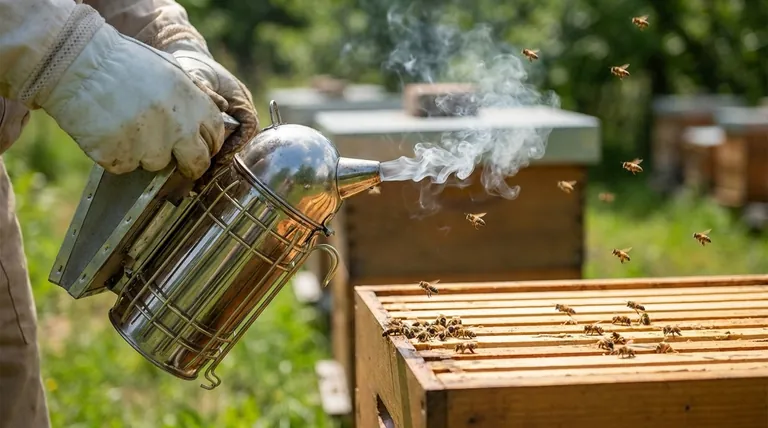At its core, smoke is a communication jammer. It works by overwhelming a honey bee colony's primary method of signaling danger. By masking their chemical alarm system and simultaneously triggering a powerful survival instinct, smoke redirects the bees' focus from defending the hive to preparing for a potential evacuation.
Smoke doesn't truly "calm" bees; it overwhelms their senses and exploits their evolutionary response to fire. This shifts their collective priority from defense to self-preservation, making them significantly more manageable.

The Two-Fold Effect of Smoke on Bee Behavior
To understand why smoke is so effective, we must look at the two distinct ways it influences a colony. It's both a chemical disruption and a psychological trigger.
Jamming the Alarm Signal
Honey bees communicate threats primarily through alarm pheromones. When a guard bee perceives a danger, it releases these chemicals to alert the rest of the colony.
The molecules in smoke physically bind to the bees' antennae, which are covered in chemoreceptors. This masks the alarm pheromone, preventing the "call to arms" signal from spreading throughout the hive.
Without this chemical signal, other bees remain unaware of the perceived threat, preventing a large-scale, coordinated defensive response. The colony is not "calm" so much as it is uninformed.
Triggering a Primal Survival Instinct
For millions of years, smoke has meant one thing to bees: fire. A forest fire represents an existential threat to the hive, triggering an immediate evacuation protocol.
Faced with the need to abandon their home, the bees' first instinct is to consume as much honey as possible. This engorges their abdomens with a critical energy source for building a new hive elsewhere.
This act of gorging has a practical side effect: it makes it physically difficult for a bee to bend its abdomen into the proper angle for stinging. A bee focused on survival and full of honey is simply less inclined and less able to attack.
Understanding the Trade-offs and Proper Use
While smoke is an indispensable tool, it's crucial to recognize it as an intentional stressor. Misusing it can be counterproductive and harmful to the colony.
Smoke Is a Stressor, Not a Sedative
You are not drugging the bees into a placid state. You are creating a perceived crisis that distracts them from your presence. They are agitated and dealing with what they believe is a life-threatening emergency.
Over-smoking can overwhelm the colony, agitate them excessively, or even cause them to abscond (abandon the hive) permanently.
The Goal is Gentle Disruption
The most effective technique involves using cool, white smoke. A few gentle puffs at the hive entrance and under the lid are often sufficient.
Hot, dense smoke can anger and harm the bees, negating the intended effect. The goal is to gently interrupt communication and trigger the feeding response, not to flood the hive with choking fumes.
Making the Right Choice for Your Goal
Understanding the "why" behind smoking bees allows you to apply it with greater precision and care.
- If your primary focus is a routine inspection: Use minimal, cool smoke at the entrance and then under the cover to gently mask any initial alarm pheromones from guard bees.
- If your primary focus is managing a defensive colony: Apply smoke more deliberately to interrupt their defensive coordination, buying you the time to work without triggering a mass response.
- If your primary focus is bee welfare: Always remember that smoke is a tool of distraction, not sedation, and should be used as sparingly as possible to accomplish your task safely.
Understanding smoke as a tool for behavioral influence, not just calming, allows for a more effective and responsible approach to beekeeping.
Summary Table:
| Effect of Smoke | Key Mechanism | Result for the Beekeeper |
|---|---|---|
| Jams Alarm Signals | Smoke molecules bind to bee antennae, masking alarm pheromones. | Prevents coordinated defensive response from the colony. |
| Triggers Survival Instinct | Mimics a forest fire, prompting bees to gorge on honey. | Bees are less inclined and less able to sting due to full abdomens. |
Master hive management with the right tools from HONESTBEE.
Understanding bee behavior is the first step; having reliable, high-quality equipment is the next. Whether you're a commercial apiary managing hundreds of hives or a distributor supplying the beekeeping community, the right gear is non-negotiable for safety and efficiency.
HONESTBEE supplies durable, effective beekeeping supplies and equipment through our wholesale-focused operations. Let us equip you for success.
Contact our team today to discuss your wholesale needs and ensure your operation is built on a solid foundation.
Visual Guide

Related Products
- European Stainless Steel Bee Smoker for Honey Bee Hive
- Stainless Steel Honey Bee Smoker Hive and Honeycomb Smoker for Beekeeping
- Economy Galvanized Beekeeping Honey Bee Smoker for Wholesale
- Premium Traditional Copper Bee Smoker with Bellows
- Stainless Steel Electric Beehive Smoker for Beekeeping and Bee Keeper Use
People Also Ask
- Can you use too much smoke on bees? The Right Way to Use a Bee Smoker for Calm Inspections
- What are the benefits of cleaning a bee smoker? Ensure Hive Safety and Bee Health
- What are the advantages of a high-quality bee smoker? Achieve Calm, Confident Hive Management
- What are the key benefits of using a bee smoker? Master Hive Inspections Safely and Efficiently
- How does a smoker help during hive inspections? The Key to Calm, Safe Beekeeping



















